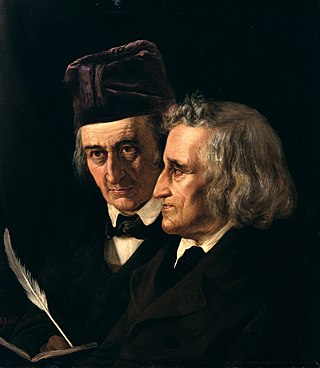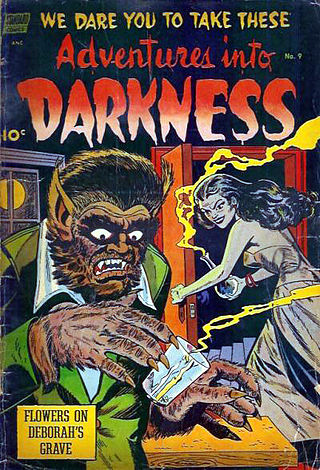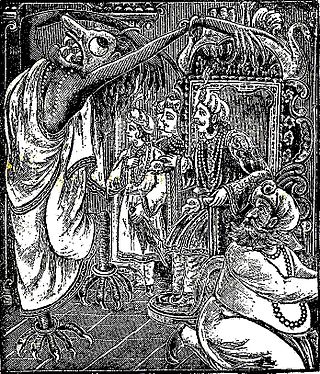
Horror is a film genre that seeks to elicit fear or disgust in its audience for entertainment purposes.

Nasreddin or Nasreddin Hodja (1208–1285) is a character in the folklore of the Muslim world from the Balkans to China, and a hero of humorous short stories and satirical anecdotes. There are frequent statements about his existence in real life and even archaeological evidence in specific places, for example, a tombstone in the city of Akşehir, Turkey. At the moment, there is no confirmed information or serious grounds to talk about the specific date or place of Nasreddin's birth, so the question of the reality of his existence remains open.

An urban legend is a genre of folklore comprising claims or stories circulated as true, especially as having happened to a "friend of a friend" or a family member, often with horrifying, humorous, or cautionary elements. These legends can be entertaining but often concern mysterious peril or troubling events, such as disappearances and strange objects or entities. Urban legends may confirm moral standards, reflect prejudices, or be a way to make sense of societal anxieties. In the past, urban legends were most often circulated orally, at gatherings and around the campfire for instance. Now, they can be spread by any media, including newspapers, mobile news apps, e-mail, and most often, social media. Some urban legends have passed through the years/decades with only minor changes, in where the time period takes place. Generic urban legends are often altered to suit regional variations, but the lesson or moral generally remains the same.

The Brothers Grimm, Jacob (1785–1863) and Wilhelm (1786–1859), were German academics who together collected and published folklore. The brothers are among the best-known storytellers of folktales, popularizing stories such as "Cinderella", "The Frog Prince", "Hansel and Gretel", "Little Red Riding Hood", "Rapunzel", "Rumpelstiltskin", "Sleeping Beauty", and "Snow White". Their first collection of folktales, Children's and Household Tales, began publication in 1812.

Anansi or Ananse is an Akan folktale character associated with stories, wisdom, knowledge, and trickery, most commonly depicted as a spider, in Akan folklore. Taking the role of a trickster, he is also one of the most important characters of West African, African American and West Indian folklore. Originating in Ghana, these spider tales were transmitted to the Caribbean by way of the transatlantic slave trade. Anansi is best known for his ability to outsmart and triumph over more powerful opponents through his use of cunning, creativity and wit. Despite taking on a trickster role, Anansi often takes centre stage in stories and is commonly portrayed as both the protagonist and antagonist.

"Little Red Riding Hood" is a European fairy tale about a young girl and a sly wolf. Its origins can be traced back to several pre-17th-century European folk tales. The two best known versions were written by Charles Perrault and the Brothers Grimm.

Werewolf fiction denotes the portrayal of werewolves and other shapeshifting therianthropes, in the media of literature, drama, film, games and music. Werewolf literature includes folklore, legend, saga, fairy tales, Gothic and horror fiction, fantasy fiction and poetry. Such stories may be supernatural, symbolic or allegorical. A classic cinematic example of the theme is The Wolf Man (1941) which in later films joins with the Frankenstein Monster and Count Dracula as one of the three famous icons of modern day horror. However, werewolf fiction is an exceptionally diverse genre, with ancient folkloric roots and manifold modern re-interpretations.

A changeling, also historically referred to as an auf or oaf, is a human-like creature found throughout much of European folklore. A changeling was a substitute left by a supernatural being on kidnapping a human being. Sometimes the changeling was a 'stock', more often the changeling was a supernatural being made magically to look like the kidnapped human. Supernatural beings blamed for stealing children included fairies, demons, trolls, nereids and many others. Usually, the kidnapped human was a child; but there were cases, particularly in Scandinavia and Ireland where adults were taken.
A teaching story is a narrative that has been deliberately created as a vehicle for the transmission of wisdom. The practice has been used in a number of religious and other traditions, though writer Idries Shah's use of it was in the context of Sufi teaching and learning, within which this body of material has been described as the "most valuable of the treasures in the human heritage". The range of teaching stories is enormous, including anecdotes, accounts of meetings between teachers and pupils, biographies, myths, fairy tales, fables and jokes. Such stories frequently have a long life beyond the initial teaching situation and have contributed vastly to the world's store of folklore and literature.

The Boy Who Cried Wolf is one of Aesop's Fables, numbered 210 in the Perry Index. From it is derived the English idiom "to cry wolf", defined as "to give a false alarm" in Brewer's Dictionary of Phrase and Fable and glossed by the Oxford English Dictionary as meaning to make false claims, with the result that subsequent true claims are disbelieved.
Tailypo is a creature of North American folklore, particularly in Appalachia. Alternate names include Taileybone, Taileybones, Tailbones, Tallie Tale, Taily Po, Taileypo and Tailipoe.
A rainbow party is a supposed group sex event featured in an urban legend spread since the early 2000s. A variant of other sex party urban myths, the stories claim that at these events, allegedly increasingly popular among adolescents, girls wearing various shades of lipstick take turns fellating boys in sequence, leaving multiple colors on their penises.
Public information films (PIFs) are a series of government-commissioned short films, shown during television advertising breaks in the United Kingdom. The name is sometimes also applied, faute de mieux, to similar films from other countries, but the US equivalent is the public service announcement (PSA). Public information films were commonplace from the 1950s until the 2000s. However, they became obsolete with the closure of the Central Office of Information.

Child cannibalism or fetal cannibalism is the act of eating a child or fetus. Children who are eaten or at risk of being eaten are a recurrent topic in myths, legends, and folktales from many parts of the world. False accusations of the murder and consumption of children were made repeatedly against minorities and groups considered suspicious, especially against Jews as part of blood libel accusations.
The killer in the backseat is an urban legend from the United States and United Kingdom. It was first noted by folklorist Carlos Drake in 1968 in texts collected by Indiana University students.
Grizzly Tales for Gruesome Kids is the generic trademarked title for a series of award-winning children's books by British author Jamie Rix which were later adapted into an animated television series of the same name produced for ITV. Known for its surreal black comedy and horror, the franchise was immensely popular with children and adults, and the cartoon became one of the most-watched programmes on CITV in the 2000s; a reboot of the cartoon series was produced for Nickelodeon UK and NickToons UK in 2011 with 26 episodes with the added tagline of Cautionary Tales for Lovers of Squeam!. The first four books in the series were published between 1990 and 2001 by a variety of publishers and have since gone out of print but are available as audio adaptations through Audible and iTunes. The ITV cartoon was produced by Honeycomb Animation and aired between 2000 and 2006 with 6 series; reruns aired on the Nickelodeon channels along with the 2011 series.

Ghosts are an important and integral part of the folklore of the socio-cultural fabric of the geographical and ethno-linguistic region of Bengal which presently consists of Bangladesh and the Indian states of West Bengal and Tripura. Bengali folktales and Bengali cultural identity are intertwined in such a way that ghosts depicted reflect the culture it sets in. Fairy tales, both old and new, often use the concept of ghosts. References to ghosts are often found in modern-day Bengali literature, cinema, radio and television media. There are also alleged haunted sites in the region. The common word for ghosts in Bengali is bhoot or bhut. This word has an alternative meaning: 'past' in Bengali. Also, the word Pret is used in Bengali to mean ghost. In Bengal, ghosts are believed to be the unsatisfied spirits of human beings who cannot find peace after death or the souls of people who died in unnatural or abnormal circumstances like murders, suicides or accidents. Non-human animals can also turn into ghosts after their death. But they are often associated with good luck and wealth in Bangladesh.

Off Season is a horror novel written by Jack Ketchum and initially published by Ballantine Books in 1980. It was Ketchum's first novel and was partially based upon the legend of Sawney Bean, which also inspired Wes Craven's 1977 cult classic horror film The Hills Have Eyes.

Cautionary Tales for Children: Designed for the Admonition of Children between the ages of eight and fourteen years is a 1907 children's book written by Hilaire Belloc. It is a parody of the cautionary tales that were popular in the 19th century. The work is in the public domain in the United States.

The Slender Man is a fictional supernatural character that originated as a creepypasta Internet meme created by Something Awful forum user Eric Knudsen in 2009. He is depicted as a thin, unnaturally tall humanoid with a featureless white head and face, wearing a black suit.














